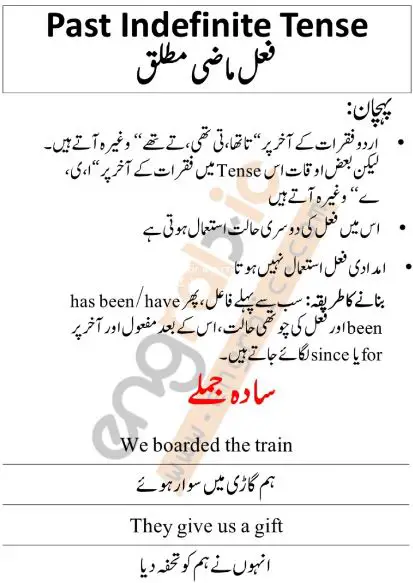This is a common problem among beginners. But don’t worry. You can still write a good blog on Past Indefinite Tense in Urdu even if you don’t know what Past Indefinite Tense is. In order to express yourself in English, you must have at the very least a fundamental understanding of grammar if you hope to put together any sort of well-formed sentence. In the English language, there is a myriad of suffixes that can change the meaning of certain words so much so that they can cause a whole new set of ideas and meanings to form as a result. These spelling variations are technically often called tenses; past indefinite being one such type. By learning how these function in our language, you will be able to use them much more effectively while writing or speaking and ultimately this could mean quite an improvement in your overall writing skill and even your grades!
What is a Past Indefinite Tense?
Past Indefinite Tense is used to express a completed action in the past. In the past indefinite tense, the verb ‘to be’ is used without ‘to’ before the subject. The verb, ‘to be’ is used in different forms like: was, were, am/is/are.

In short, there is no time frame in such sentences that provides information on the exact duration of the past action or the situation in the past.
1.Introduction to Past Indefinite Tense and its importance in Urdu.
Past Tense is used to express completed action in the past tense. Generally, Past Indefinite Tense is used in formal or written English. In Urdu, “Kam” (کم) is used to represent past tense and it is generally added in the end or before the verb. The verb without “Kam” (کم) is used for ongoing or unfinished action. Here are the examples of Past Tense using “Kam” (کم) with some verbs in Urdu: Present Tense: Present Continuous Tense: Past Tense: I am studying. I was studying. I am going to study. I was going to study. I have been studying. I had been studying. I have been going to study. I had been going to study.
2. Past Indefinite Tense with Examples in the Urdu Language.
Urdu language tenses are, past indefinite, present indefinite, present perfect, past perfect, future, future perfect, and future continuous. We can make some sentences using past indefinite tense of Urdu language,
Here are the Examples.

3. Learn Past Indefinite Tense.
The past indefinite tense is used to talk about something in the past that happened on one specific day. It is good for talking about one day in the past, a period of time in the past, or a specific activity in the past. We use one day, a period of time, or a specific activity to talk about a specific day in the past.
4. Learn Past Indefinite Tense in Urdu with Examples.
As you know, the past indefinite tense has only one form, i.e. “ Past Indefinite Tense in Urdu with Examples. ” But, this is for all situations/contexts. Here, I am going to show you how to use it in different situations/contexts.
5.How to form Past Indefinite Tense in Urdu?
In Urdu, there is no special past tense verb form because verbs conjugate based on the subject. So we will just add the subject pronouns to the verb to form the past tense. So, let us take a verb:
[wptb id=90]
6.Why you should use past indefinite tense?
It is important to note that the use of past indefinite tense is in most cases optional. Many native speakers choose to omit it when the context is clear and in old-fashioned writing. However, this tense is a form of ‘strong’ writing to use in non-fiction for example. Its usage adds length, strength, and rigor to your work. It is an important part of the grammar of writing.
7.Affirmative – Positive phrases in the indefinite past tense
“ I went to London last month.” “ I went to London last year.” “ I have a car.” “ I had a car last year.” “ I had a car last month.” If a sentence has a present tense verb, but it is talking about the past, then it has to be affirmative –positive in the past tense. But if a sentence has a past tense verb, but it is talking about the past, then it has to be affirmative – negative in the past tense.
Examples:

8.What is the “indefinite clear aspect”
The term ‘adverb’ is used to group all adverbs contained in the indefinite aspect. It is the verb’s appearance, not its individual definition that determines a word as either an adjective or an adverb. For example: “He slowly opened the door.” The same action that makes “slowly” an adjective modifying the verb definition also makes “open” an adverb by modifying its time of performance.
Conclusion
We hope you enjoyed our article about past indefinite tense sentences in Urdu and English. With this knowledge, we know that you can make the most of your time learning the past indefinite tense sentences in Urdu and English. So what are you waiting for? Start Learning!
And If you have any questions or queries then feel free to ask in the comments sections and we will respond to you as soon as possible and visit PP Urdu regularly for the latest study updates.